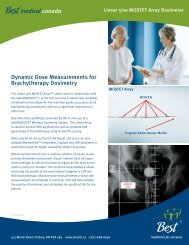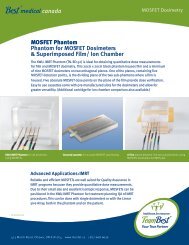operator's manual wireless dosimetry system - Best Medical Canada
operator's manual wireless dosimetry system - Best Medical Canada
operator's manual wireless dosimetry system - Best Medical Canada
You also want an ePaper? Increase the reach of your titles
YUMPU automatically turns print PDFs into web optimized ePapers that Google loves.
OPERATOR'S MANUAL FOR THE SYSTEM<br />
3. The detector is inserted into the central branch of an approved three way sterile<br />
catheter via a ‘Y’ connector (see Figure 5-6: MOSFET Linear 5ive Array Before<br />
Insertion in the 3-Way Catheter), which then is inserted in the urethra, rectum or<br />
bladder. The radio-opaque marker, located on the tip of the array, helps visualize,<br />
under fluoroscopy or CT, the 5 MOSFET positions relative to the internal bladder<br />
wall (at the lower edge of the catheter balloon). The array size, its waterproof cable,<br />
and the use of a Y type connector make body fluid evacuation clean and easy,<br />
helping to make the patient more comfortable.<br />
During the LDR Implant or HDR Procedure:<br />
1. During the implant or HDR procedure, 5 dose points can be read directly from the<br />
array, or remotely from a computer, displaying the real urethral dose profile<br />
throughout the prostate location, compared to the planned profile.<br />
2. From urethra dose readings, one can infer the maximum initial dose rate (IDRmax)<br />
to the urethra and compare it to the recommended dose limit (1.5-2 mPD:<br />
minimal Peripheral Dose). The measured dose versus distance curve along the<br />
prostatic urethra contains the information about two factors related to the quality<br />
of the implant: the dose rate at the base of the prostate and the length of urethra<br />
that receives the mPD, compared to the length of the urethra measured with<br />
ultrasound.<br />
End of Implant Procedure:<br />
1. After the implant, real time <strong>dosimetry</strong> using the Linear Array MOSFET Dosimeter<br />
allows for correction of lack of the proper dose coverage at the prostate base.<br />
However there is no practical way to reduce an excessive urethral dose, except<br />
that a patient may be followed closely during post treatment phase and<br />
considered to be at increased risk for urethral complications.<br />
Figure 5-6: MOSFET Linear 5ive Array Before Insertion in the 3-Way Catheter<br />
Page 48 of 62




